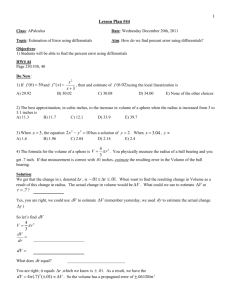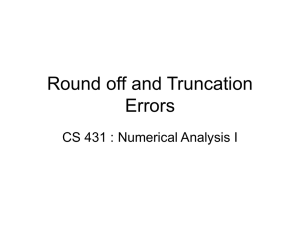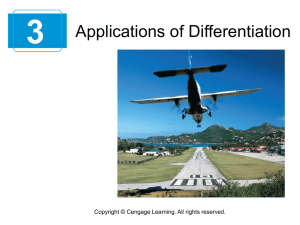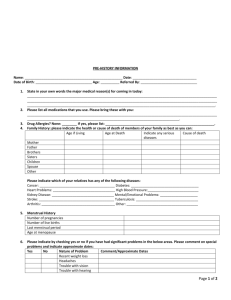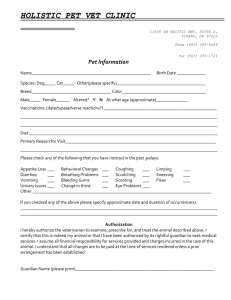Class Notes
advertisement
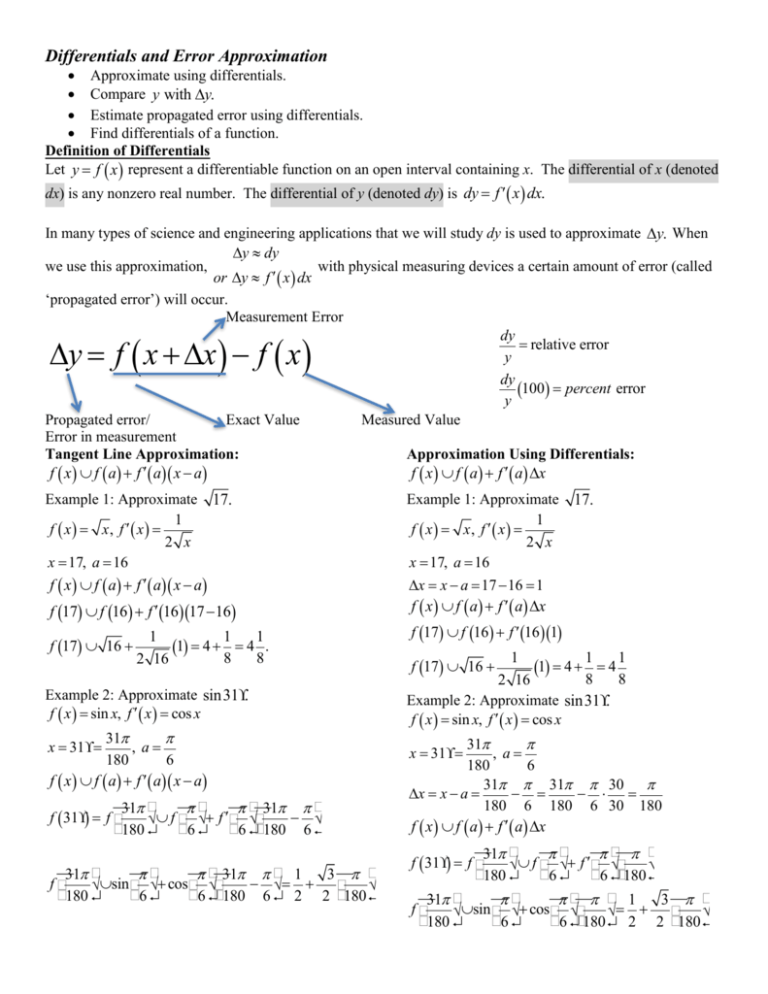
Differentials and Error Approximation Approximate using differentials. Compare y with Dy. Estimate propagated error using differentials. Find differentials of a function. Definition of Differentials Let y = f ( x ) represent a differentiable function on an open interval containing x. The differential of x (denoted dx) is any nonzero real number. The differential of y (denoted dy) is dy = f ¢ ( x ) dx. In many types of science and engineering applications that we will study dy is used to approximate Dy. When Dy » dy we use this approximation, with physical measuring devices a certain amount of error (called or Dy » f ¢ ( x ) dx ‘propagated error’) will occur. Measurement Error dy = relative error y dy (100) = percent error y Propagated error/ Exact Value Measured Value Error in measurement Tangent Line Approximation: Approximation Using Differentials: Dy = f ( x + Dx ) - f ( x ) f ( x ) » f ( a) + f ¢ ( a) ( x - a) Example 1: Approximate 1 f ( x ) = x, f ¢ ( x ) = 2 x x = 17, a = 16 f ( x ) » f ( a) + f ¢( a) Dx 17. f ( x ) » f ( a) + f ¢ ( a) ( x - a) f (17) » f (16) + f ¢ (16) (17 -16) f (17) » 16 + 1 1 1 (1) = 4 + = 4 . 8 8 2 16 Example 2: Approximate sin31°. f ( x ) = sin x, f ¢ ( x ) = cos x 31p p , a= 180 6 f ( x ) » f ( a) + f ¢ ( a) ( x - a) x = 31° = æ 31p ö f (31°) = f ç ÷» è 180 ø æp ö æ p öæ 31p p ö f ç ÷ + f ¢ç ÷ç - ÷ è6ø è 6 øè 180 6 ø æ 31p ö æp ö æ p öæ 31p p ö 1 3æ p ö fç - ÷= + ç ÷ » sin ç ÷ + cos ç ÷ç ÷ è 180 ø è6ø è 6 øè 180 6 ø 2 2 è 180 ø Example 1: Approximate 17. 1 f ( x ) = x, f ¢ ( x ) = 2 x x = 17, a = 16 Dx = x - a = 17 -16 = 1 f ( x ) » f ( a) + f ¢( a) Dx f (17) » f (16) + f ¢ (16) (1) 1 1 1 (1) = 4 + = 4 8 8 2 16 Example 2: Approximate sin31°. f ( x ) = sin x, f ¢ ( x ) = cos x f (17) » 16 + 31p p , a= 180 6 31p p 31p p 30 p Dx = x - a = - = - × = 180 6 180 6 30 180 f ( x ) » f ( a) + f ¢( a) Dx x = 31° = æ 31p ö f (31°) = f ç ÷» è 180 ø æp ö æ p öæ p ö f ç ÷ + f ¢ç ÷ç ÷ è6ø è 6 øè 180 ø æ 31p ö æp ö æ p öæ p ö 1 3æ p ö fç ÷ » sin ç ÷ + cos ç ÷ç ÷= + ç ÷ è 180 ø è6ø è 6 øè 180 ø 2 2 è 180 ø Now let’s look at a graph to get an understanding of the relationship between x, y, dx, dy, Dx, and Dy. In the grid provided, carefully graph y = x 3. Next, carefully graph the tangent line to the curve through x =1. Our focus will be from x =1 to x = 2. Label the following on your graph. Dx = change in x on f ( x ). Dy = change in y on f ( x ). dx = change in x on f ¢ ( x ).üï ý These are called differentials. dy = change in y on f ¢ ( x ).ïþ Classwork Examples: Page 236, 8, 10, 14, 20, 22, 28, 30, 36 Evaluate and compare Dy and dy. 8. y = 6 - 2x 2 , x =1, Dx = dx = 0.1 Find the differential dy of the function. 14. y = csc2x 22. Use differentials and the graph of f to approximate (a) f (1.9) and (b) f ( 2.04) . (a) (b) 10. y = 2 - x 4, x = 2, Dx = dx = 0.01 20. y = sec 2 x x 2 +1 28. The measurement of the circumference of a circle is found to be 64 centimeters with a possible error of 0.9 centimeters. (a) Approximate the percent error in computing the area of the circle. (b) Estimate the maximum allowable percent error in measuring the circumference if the error in computing the area cannot exceed 3%. 30. The radius of a spherical balloon is measured as 8 inches, with a possible error of 0.02 inch. (a) Use differentials to approximate the possible propagated error in computing the volume of the sphere. (b) Use differentials to approximate the possible propagated error in computing the surface area of the sphere. 36. A surveyor standing 50 feet from the base of a large tree measures the angle of elevation to the top of the tree as 71.5°. How accurately must the angle be measured if the percent error in estimating the height of the tree is to be less than 6%?
